An initial reading of the Chancellor's Autumn statement reveals that the go-ahead has been given to the TransPennine electrification and the strategic Oxford-Bedford line.
These are two of dozens of projects around the country that cumulatively represent excellent value for money. We need a rolling programme of such schemes.
30 Nov 2011
18 Nov 2011
Trains too long
Chiltern Railways has extended a service to London by an extra carriage; great for easing overcrowding, but less helpful to the commuters stuck at Saunderton station because their platform is too short.
Is it beyond the ingenuity of the industry's engineers to devise a system with a detector and locking system so that a door can be opened only if there is a station platform alongside?
Article here
Is it beyond the ingenuity of the industry's engineers to devise a system with a detector and locking system so that a door can be opened only if there is a station platform alongside?
Article here
16 Nov 2011
The lost route into London
Before the electrification of the West Coast Main Line, there were two routes from London to Birmingham, with little to choose between them. The direct Great Western route, which ran through High Wycombe and Bicester, was then more or less abandoned as a through service, with the section from High Wycombe to Aynho Junction being reduced to single track.
Since privatisation, the route has been upgraded and converted back to double track. Earlier this year Chiltern Railways introduced a through service from Marylebone to Birmingham, and there is even a suggestion to electrify the route.
Unfortunately, further development is going to be limited by restrictions at Marylebone, which in the space of twenty years has been transformed from a sleepy backwater to a very busy station with a large volume of local traffic.
There is, however, another route into London which is scarcely used - the former main line into Paddington which branches off the Great Western route to the west at Old Oak Common and then run alongside the Central Line to Ruislip; the line from Marylebone joins this line at Northolt Junction.
At present it would not be possible to increase the amount of traffic on this route due to the volume of traffic using Paddington. If, on the other hand, the Heathrow Express were removed and given an underground terminus of its own, as part of the Crossrail project, this would reinstate the entire route and double the capacity between London and Birmingham.
Since privatisation, the route has been upgraded and converted back to double track. Earlier this year Chiltern Railways introduced a through service from Marylebone to Birmingham, and there is even a suggestion to electrify the route.
Unfortunately, further development is going to be limited by restrictions at Marylebone, which in the space of twenty years has been transformed from a sleepy backwater to a very busy station with a large volume of local traffic.
There is, however, another route into London which is scarcely used - the former main line into Paddington which branches off the Great Western route to the west at Old Oak Common and then run alongside the Central Line to Ruislip; the line from Marylebone joins this line at Northolt Junction.
At present it would not be possible to increase the amount of traffic on this route due to the volume of traffic using Paddington. If, on the other hand, the Heathrow Express were removed and given an underground terminus of its own, as part of the Crossrail project, this would reinstate the entire route and double the capacity between London and Birmingham.
14 Nov 2011
More Electrostars coming to Southern?



Electrostars, the EMU originally developed by AdTranz before it was taken over by Bombardier, are a mixed bunch. The first entered service around 2000 and comprise classes 357, 375, 376, 377, 378 and 379. Originally they were quite unreliable but they are now in the same league as the EPB units which they replaced, dating from the 1960s.
Variations include alternative seating layouts, sliding or plug doors, full width cabs or half-cabs with gangways (top picture), and AC, DC or dual voltage types.
Probably the most successful version is the class 378 for London Overground (second picture), which has sliding doors and longitudinal seating, an ideal layout for the type of service for which they are used.
Some versions are very comfortable, for example the end cars in the units operating on the Southern main lines (third picture) have 2+2 seating with tables, all aligned to the windows.
Much less satisfactory are the vehicles with 2+3 seating. The bodyshells are not wide enough for 2+3 seating, due to the way the bodysides are curved below the window, with the space being further cut into by ducts at skirting level. This reduces the width at floor level, so that passengers sitting by the window cannot put both feet on the ground straight in front of them, and the gangway is so narrow that special catering trolleys had to be obtained.
The reason for this curvature is not clear because the steps project beyond it, and platform levels are always well below the level of the bottom of the bodyside. It appears to be nothing more than a styling feature, and whilst it looks quite elegant, style should not be at the expense of space and comfort.

Another fault is that at concave platforms there is a large gap between the platform and the train. This is due to the position of the doors. The closer the doors are to the bogie centres, the less the gap at curved platforms. Trains such as the end-door class 158 are particularly good from this point of view.
The argument for locating the doors more centrally is that it improves station dwell times, but getting on and off Electrostars at some platforms at stations like Clapham Junction can be a bit of an adventure as there is a chasm to be negotiated. This cannot be good for station dwell time. There is a need for more research on this topic.
One way and another, the Electrostars would benefit from design changes to address these issues before further examples are built.
9 Nov 2011
Transport Select Committee ifs and buts
In its report published yesterday, the Select Committee has succeeded in drawing opposite conclusions simultaneously. The headline can be taken as a go-ahead signal - but the qualifications are so many and so significant (see preceding post) that it must be read as a recommendation to stop and reconsider the project.
It seems to me that the real question that still needs to be asked is whether, given a decision to spend this amount on transport, high speed rail is the best investment.
To get at the cost of an alternative, a comparison is the reconstruction of the line between Edinburgh and Tweedbank, a 49km stretch, at a cost of around £250 million - £5 million per km. The cost of the 200km HS2 line between London and Birmingham is given as £16 billion - £80 million per km. However, HS2 includes some very expensive tunneling at the London end which would have to be constructed regardless if capacity is to be increased, whilst the Edinburgh to Tweedbank route will not of course, be electrified, and is partially single track. Taking account of these differences, a reasonable estimate for reinstating an existing alignment as a good quality main line would be around £10 million per km for a double track route, plus another £2 million for electrification - a total of around £12 million.
Thus, the same amount of money will buy many times more conventional railway - and there are worthwhile schemes all over the country waiting to be built, mostly involving reinstatement of Beeching closures in areas where the population has greatly increased, reinstatement of double-track routes which have been singled, works to remove bottlenecks and speed restrictions, and electrification. The route of HS2 itself could be one such reinstatement, and would provide the same capacity enhancement. The existing GC main line alignment, whilst suitable as a conventional railway, cannot, however, be made into a high speed line.
The poor value for money also applies to rolling stock. A standard high speed train costs £30 million - that is the price of two conventional trains with the same capacity, or six 4-car Electrostars. But the aim is that some trains would be able to run onto the existing rail network. These would need to be specially designed and cost around £52 million each. This extra cost reflects both the non-standard design and the premium for a one-off order.
It is considerations such as these that the government must now take into account before proceeding further.
It seems to me that the real question that still needs to be asked is whether, given a decision to spend this amount on transport, high speed rail is the best investment.
To get at the cost of an alternative, a comparison is the reconstruction of the line between Edinburgh and Tweedbank, a 49km stretch, at a cost of around £250 million - £5 million per km. The cost of the 200km HS2 line between London and Birmingham is given as £16 billion - £80 million per km. However, HS2 includes some very expensive tunneling at the London end which would have to be constructed regardless if capacity is to be increased, whilst the Edinburgh to Tweedbank route will not of course, be electrified, and is partially single track. Taking account of these differences, a reasonable estimate for reinstating an existing alignment as a good quality main line would be around £10 million per km for a double track route, plus another £2 million for electrification - a total of around £12 million.
Thus, the same amount of money will buy many times more conventional railway - and there are worthwhile schemes all over the country waiting to be built, mostly involving reinstatement of Beeching closures in areas where the population has greatly increased, reinstatement of double-track routes which have been singled, works to remove bottlenecks and speed restrictions, and electrification. The route of HS2 itself could be one such reinstatement, and would provide the same capacity enhancement. The existing GC main line alignment, whilst suitable as a conventional railway, cannot, however, be made into a high speed line.
The poor value for money also applies to rolling stock. A standard high speed train costs £30 million - that is the price of two conventional trains with the same capacity, or six 4-car Electrostars. But the aim is that some trains would be able to run onto the existing rail network. These would need to be specially designed and cost around £52 million each. This extra cost reflects both the non-standard design and the premium for a one-off order.
It is considerations such as these that the government must now take into account before proceeding further.
8 Nov 2011
Transport Select Committee publishes HS2 report
There is a good case for a high speed rail network, linking London and the major cities of the Midlands, the North and Scotland says the Commons Transport Committee.
The Transport Committee sets out a series of recommendations on high speed rail:
Launching High Speed Rail – the report of the inquiry into high speed rail, including the Government’s proposal for HS2 – committee chair Louise Ellman said,
"A high speed rail network, beginning with a line between London and the West Midlands, would provide a step change in the capacity, quality, reliability and frequency of rail services between our major cities.
A high speed line offers potential economic and strategic benefits which a conventional line does not, including a dramatic improvement in connectivity between our major cities, Heathrow and other airports, and the rest of Europe.
High speed rail may be a catalyst for economic growth, helping to rebalance the economy and bridge the north-south divide. But the Government must do more to promote local and regional growth strategies to ensure we get maximum economic benefit from high speed rail.
High speed rail is affordable: HS2 will cost around £2 billion per annum over 17 years. Construction of a high speed rail network should start with the line between London and the West Midlands, as this is where capacity needs are greatest. But we are concerned that under current plans high speed rail lines won’t reach Manchester and Leeds for more than 20 years.
The Government should also look at options to build southwards from the north and link to other lines such as the Midland Main Line. We see no reason why the Scottish Government should not begin work on a Scottish high speed line, to connect with the English network in due course.
Investment in HS2 must not lead to reduced investment in the 'classic' rail network. We are concerned that the Government is developing separate strategies for rail and aviation, with HS2 separate from both. We call again for the publication of a comprehensive transport strategy.
Investment in high speed rail has potential to boost growth but may have a substantial negative impact on the countryside, communities and people along the route. This must be better reflected in the business case for HS2 and future phases of the project. We would encourage the Government to follow existing transport corridors wherever possible."Recommendations
The Transport Committee sets out a series of recommendations on high speed rail:
- The Government must firmly commit to the Y network before seeking parliamentary approval for HS2
- If the Government decides to go ahead with HS2, it should publish a summary of the financial case showing how the project is affordable alongside sustained investment in the classic network as well as its priorities for expenditure in the next Network Rail control period (for 2014-19)
- More information about the Y network (to Leeds and Manchester) such as the location of stations and environmental impacts should be published and strategically appraised before a final decision on HS2 is made
- A full assessment of the case for building from north to south should be carried out as a priority
- It is disappointing that a major strategic scheme is being designed and assessed to a large extent based upon the value of travel time savings, which are not universally accepted. This issue should be addressed in the updated economic case for HS2 with the implications for scheme design made explicit
- The Government needs to make clear how HS2 fits into its wider aviation strategy, looking again at the case for a direct link to Heathrow in phase I on the assumption that the high speed rail network will extend to Manchester and Leeds. The costs and benefits of routing HS2 via Heathrow should be set out more clearly and there should be a clear statement about the status of possible complementary schemes such as those which would link Heathrow by rail to Gatwick or the Great Western Main Line
- Better information should be provided to explain the Government's rationale for its proposals for London termini and linkages, which are the most expensive and complex elements of HS2
- Operating 18 trains per hour at 225mph are risk factors for which more technical information should be published. It is questionable whether the system proposed is being designed with sufficient margin for expansion
- Claims that HS2 would deliver substantial carbon-reduction benefits do not stand up to scrutiny. However, HS2 will produce less carbon than an expanded motorway network or greater domestic aviation in the event of increased demand for inter-urban travel
- Government support to enable the full potential of high speed rail to be realised, - including funding, for the development of regional and local strategies for transport, housing, skills and employment - should be recognised as a priority
- When announcing its decision on HS2, the Government should provide a more explicit and comprehensive statement about likely patterns of service on the classic network once HS2 is operational
- The Government should engage with Network Rail to identify whether there are affordable options to enable more peak-time capacity to be provided for Milton Keynes and Northampton commuters before HS2 opens
- The Government should desist from disparaging opponents of high speed rail as NIMBYs. Both sides in the debate should show respect for each other and focus on the facts
Subscribe to:
Comments (Atom)

